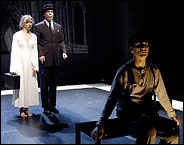 When a person dies in the prime of life, the natural tendency of the survivors is to rant and rave and perhaps curse God and question why their loved one had to die too young. These days friends understand what’s going on. We have bereavement counselors and people like Kubler-Ross letting us know that anger is one of the stages of grief and that it’s OK to be angry and to question the logic of God’s allowing a young person to die.
When a person dies in the prime of life, the natural tendency of the survivors is to rant and rave and perhaps curse God and question why their loved one had to die too young. These days friends understand what’s going on. We have bereavement counselors and people like Kubler-Ross letting us know that anger is one of the stages of grief and that it’s OK to be angry and to question the logic of God’s allowing a young person to die.Back in 1401, when Johannes von Saaz’s beloved wife died in childbirth, people just didn’t go around questioning the Almighty. People were supposed to hunker down in their huge cathedrals and accept the will of God.
So von Saaz’s 34 chapter, “Death and the Ploughman,” which presents a grief-stricken ploughman engaging in a bitter dialogue with Death over the loss of his wife, was not widely known in the author’s time, and not translated from the German and presented on the stage until 1977.
A new translation by Michael West opened Wednesday night on the Main Stage at UCD, under the direction of Anne Bogart and performed by members of the SITI Company.
As the audience entered the theater, the three characters were already on stage, moving in a painstakingly slow, stylized manner to the relentless music of Nine Sili Nebesniya, composed by Sheremetieve, a tune which is not likely to be found on my iPod any time soon.
Death, looking like Rene Magritte’s Man in a Bowler Hat, is played by Stephen Webber, with Will Bond as the Ploughman and Ellen Lauren as the Woman.
The Ploughman opens the dialog with a gut wrenching monologue in which all of his pain and anger comes spewing forth as he curses Death, despairs of ever finding happiness again in this life, and demands retribution from Heaven for the joy that was taken from him.
As the 90 minute play progresses, each of the actors, in turn, have lengthy monologues. There is rarely any actual conversation. The woman alternates as the Ploughman’s wife and as a supportive voice for Death.
Death seems to have an almost amused reaction to the depth of Ploughman’s grief. “You have not drunk from the fountain of wisdom. This much is clear from your words,” he says on one occasion, and on another counsels that “‘This too shall pass’ should be in the mouth of every man,” seeming to feel that it is only a matter of time before Ploughman recovers.
He also points out that Ploughman’s grief is so great because his love was so great and that to remove the grief would necessitate removing the love as well, and he gives a recitation of the kinds of positive things that cannot exist without their negative components. "Suffering is the end of love, the end of joy is sorrow. After pleasure comes the loss of pleasure." Death tells the grieving man that if he did not want to feel pain, he should not have allowed himself to love.
The Ploughman continues to harp on the injustice of mortality, while Death shows him the all the ills of the world that his wife has been spared. She died young and beautiful would never know what it was like to experience old age and watch her body begin to deteriorate.
Movement in this production is at times almost balletic, with graceful, precise moves and elaborate gestures. The choreography was a collaborative effort of the actors and the director and arose out of the “dense, articulate” language, explained the cast at a Q&A following the opening night performance. There are also moments of visual levity to break the mood when things get too heavy.
The action takes place on a black stage, bordered with white, a design by James Schuette, which is complemented by the geometric lighting design of Brian H. Scott. The only set pieces are two metal tables and a small suitcase which the woman carries.
The debate between Death and the Ploughman concludes with the arrival of God, who renders judgement as to who was the winner and why.
Director Bogart explains that Death and the Ploughman was written at a time when the theretofore accepted medieval sensibilities were suddenly called into question--faith, the meaning of life, religious hierarchy, authority--leading to the start of the Renaissance. She points out that today we are undergoing another paradigm shift where religion, values and meaning must be examined from fresh new angles.
When one watches this play, one is struck with the sense that history does indeed go in circles, and that everything old is new again, sooner or later. The issues raised in Death and the Ploughman are as fresh today as they were in 1401.

No comments:
Post a Comment